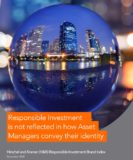Today there is an ever growing demand for more responsible investment strategies from both institutional and individual investors. In recent years the popularity of Environmental, Social and Governance (ESG) investments has risen substantially and is expected to continue doing so. The H&K Responsible Investment Brand Index, the first of its kind, has analysed all European Asset Managers ranked among the largest worldwide 400 managers with a view to validating whether good intent is also communicated at a meta level through the brand. The index evaluates actual commitment against follow-through in brand architecture.
An attractive route for Asset Managers to tap into the continued growth and popularity of ESG investments is to launch Responsible Investment Funds. Indeed, these have grown by more than 60%¹ between 2010 and 2016, from 1,503 to 2,413 in Europe alone, and over the past five years, 64%² of people have increased their allocation to sustainable investments.
Larry Fink, CEO of Blackrock, the world’s largest asset manager, connected the dots earlier this year with an open letter in which he stated “Society is demanding that companies, both public and private, serve a social purpose.”³
It is however hard to distinguish between genuine long-term commitment to sustainable investments in its larger sense and companies who just ride the hype for their own benefit. The H&K Responsible Investment Brand Index differentiates between two categories: “Commitment”, which refers to the commitment made towards responsible investment and “Brand”, which analyses to what extent sustainable development lies at the heart of a company’s identity. The index takes the view that actual Commitment is demonstrated through (1) hard facts such as, among others, committing to the Principles for Responsible Investment and (2) the intent which transpires from within Asset Managers through their brand, best visible in openly and transparently communicated vision and purpose statements.

High level of commitment, low level of branding
Over three quarters of the companies analysed (or 184 out of 239), formally commit as responsible investors. Most frequently, this is achieved by signing the Principles for Responsible Investment promoted by the United Nations. In doing so, these companies are committed to positive evolution and progress in this sphere. “We are aware of some companies such as La Banque Postale Asset Management in France who made the announcement back in April 2018 that all their assets will be managed according to responsible investment criteria by 2020” says Jean-François Hirschel, Co-Founder of the H&K Responsible Investment Brand Index, and CEO and Founder of H-Ideas, a company specialised in strategy and positioning in the financial industry. “Candriam has pushed it to the ultimate level in branding terms by making Responsibility part of its name (Conviction AND Responsibility In Asset Management). “, adds Hirschel.
45 companies (RI Laggards) were found to neither mention nor participate in any responsible investment programme. By way of contrast, 47 companies (RI Avant Gardists & RI Aspirants) achieved a brand score above the median. It is interesting to note that although 10 companies (RI Aspirants) score highly in the branding dimension, they had a low commitment rating, interpreted as their aspiration having not yet been translated into action.
The 47 RI Avant Gardists & RI Aspirants companies achieving an above-median branding score have average assets under management of 211 bn Euros which differs only slightly from the total peer group average of 202 bn Euros under management. This shows an asset manager doesn’t need to be large to actively integrate Responsible Investment into its branding. The key drivers are linked to recognising the opportunities in RI, embedding its cultural anchorage forthe long term, organisational leadership, the underlying values and how brand overall is ingrained within a company.
Geographical location also appears to have a major impact on how well Asset Managers rank in the H&K Responsible Investment Brand Index. On average, there are significantly more French businesses among the 47 best-practice companies than there are other nationalities, maybe driven by France having one of the most demanding regulations in Europe in terms of Responsible Investment. There are also above-average numbers of Swiss and Benelux Asset Managers. German companies, on the other hand, are strongly underrepresented in this respect.
Missed opportunity to differentiate and convey a clear identity
The majority of European asset management companies analysed (147, RI Traditionalists) actually commit to a responsible approach but miss the opportunity to share their approach and actively incorporate it into their brand.
Many Asset Managers still fail to articulate why they exist when evaluated against a socially relevant Purpose. The index revealed that only 13 companies have a clearly articulated Purpose, of which only 3 truly connect to a greater societal impact (Hermes Investment Management, AXA Investment Management and Swedbank Asset Management).
“A bit more thought in this space could propel many Asset Management companies into the 21st century. It’s not just about how the sector evolves, but how people think, communicate and act,” says Markus Kramer, Co-Founder of the H&K Responsible Investment Brand Index, partner at boutique brand consultancy Brand Affairs and author of The Guiding Purpose Strategy, A navigational Code for Brand Growth.
The common unifier for a successful position of both committing to ESG and reflecting this in the brand architecture is to clearly articulate and link an intrinsic, inner guiding Purpose, connected to tangible social impact.
The authors of the Responsible Investment Brand Index therefore put forward that leadership in Asset Management should make finding, articulating and communicating Purpose a strategic priority. “Especially in a world that is becoming increasingly transparent, competitive and where sustainability is on everyone’s lips, a clear definition of one’s own values and vision is the key to a successful Responsible Investment branding and long-term business success,” states Kramer.




